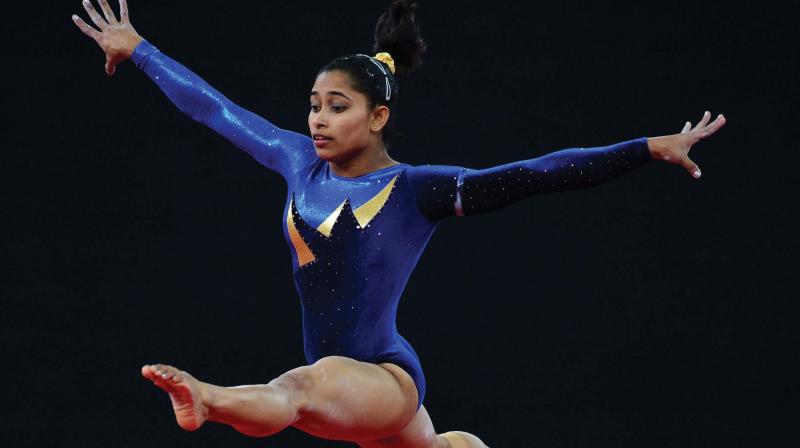Dipa practised in primitive conditions in Tripura
Dipa's performance at Rio was a trailblazer.

Gifting a BMW car to gymnast Dipa Karmakar, who finished fourth in the Rio Olympics and missed out on a medal, is a magnanimous gesture. It was a reward for her bravery in performing dangerous routines like the Produnova, entertaining the viewers and putting India on the gymnastics map of the world. In a sport in which India had limited or almost negligible international standing, Dipa’s performance at Rio was a trailblazer. The impact of her performance and popularity can hopefully spur thousands of young men and women to practise this entertaining but difficult sport.
Olympics medals have an add-on effect. The number of shooters increased in the country after Rajyavardan Singh Rathore won a silver medal in the 2004 Athens Olympics and Anbhinav Bindra got a gold medal in the 2008 Beijing Olympics. After P.V. Sindhu got a silver medal in women singles badminton, hundreds of young boys and girls wanted to join the badminton academy of Pullela Gopichand. Hopefully, Dipa’s performance can inspire a new generation of gymnasts.
Also, above all, Dipa’s performance should shake the Sports Authority of India and the sluggish Gymnastic Federation of India out of their lethargy and force them to provide international class equipment for young gymnasts in several major cities. Wrestlers Sudesh Kumar and Prem Nath, who came fourth in their respective weight categories in the 1972 Munich Olympics, and P.T. Usha, who narrowly missed out on a medal in the 400 metres hurdles in the 1984 Los Angeles Olympics, were never showered with gifts. The private sector was not so active in sports in the 1970s and 80s and so these talented Olympians never got much appreciation.
But pugilist Gurcharan Singh, who lost a bronze medal due to lack of aggression in the 2000 Sydney Olympics, also never got due recognition. In frustration Gurcharan quit amateur boxing and became a professional in USA, with limited success. Seen in such a perspective, gifting a BMW car to Dipa even though she missed a medal is a magnanimous gesture. Her refusal of the car is due to personal reasons, lack of a service centre and well developed roads in Agartala. She and her family are still hoping for monetary compensation, instead of the car.
However, it can also be viewed as misguided empathy. Dipa practised in primitive conditions at Tripura. Development of sports infrastructure, playgrounds and providing equipment is the need of the hour. If mass base for sports has to be created the private sector has to get involved, either as philanthropy or as part of Corporate Social Responsibility (CSR). Only from quantity will quality emerge. The major problem with Indian sports is that the base for sports is very limited. A quantum jump has to be made to ensure that the youth of India can play the sport of their choice in a decent playground and as they improve get proper equipment. Genuine promoters and benefactors of sports should pool their resources to nurture talent at a formative age and help realise India’s Olympic dreams. Unfortunately, as teenagers, India’s promising sportsmen and women often do not get adequate coaching or proper equipment. They thus develop technical faults that become difficult to eradicate later.
It is also a welcome sign that sponsors are moving out of the ambit and lure of cricket and are making role models of Olympic sportspersons. Cash rewards for both Sindhu and Sakshi have been generous by the Government of India, state governments, banks, public and private sector. Everybody wants to be associated with a winner. There is publicity, glory and goodwill for the donor.
However, for Indian sports to move to the next level, larger talent has to be created. This can only be done by a healthy private sector and government partnership. The disparity in Indian sports is appalling. It is a case of winner takes all. It is not fashionable to invest in playgrounds and sports equipment as it gets little publicity. However, the biblical saying goes, “As you sow so shall you reap.” Unless a mass base for sports is created like in China, we will continue to struggle at the highest level like the Olympics.
Instead of overindulging in hefty cash prizes and luxury cars to a few, it is imperative to invest for the future. Better coaching education, infrastructure and facilities are the need of the hour. Indian sports have miles to go. The interest is there. Sponsors have realised that there is life beyond cricket. But now the money and enthusiasm has to be canalised wisely and invested for future growth, rather than display misplaced empathy.
(Author is sports writer and commentator)

